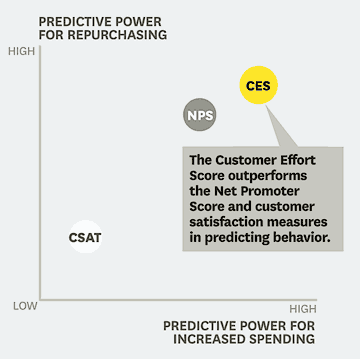What is a CES Survey? Customer Effort Score Explained

Table of Contents
Do you know how easy or difficult it is for customers to do business with you? The answer can be found using a CES survey.
CES Surveys: Understanding Customer Effort Scores
What makes for satisfied, loyal clients? Market research shows that happy clients and visitors most often result from having easy, frictionless interactions with your brand, over time. This is what the Customer Effort Score measures—quickly and easily.
The CES is centred around just one question: How easy was your latest transaction?
This key data point can be gathered after every service, sale or interaction your visitors have with you. It was designed to immediately gauge how professional and effortless was your clients’ experience.
Gartner, the original designer of the CES, explains why this simple metric is so essential:
Customer effort is the strongest driver of customer loyalty—or disloyalty. Boosting customer loyalty is good, but the larger opportunity is to keep customers from becoming disloyal… 96% of customers with a high-effort service interaction become more disloyal compared to just 9% who have a low-effort experience.
This quick metric measures ease of interactions, ease of resolutions, and ultimately client loyalty. Integrating the CES into your brand’s daily interactions can help your organisation track CX and improve upon it, exponentially.
How the CES Survey Works
What is a CES Survey? Simply put, it’s a measure of how much effort is required to interact with your business. Knowing this score can give your company key insights into potential bottlenecks or service issues that should be addressed.
By improving gaps in service, the CES helps organisations to fine-tune their own client interfacing, pointing the way to evidence-based market strategies and solutions.
Find out the facts:
- Were your visitors’ needs and expectations met, consistently?
- How smooth was your client’s latest purchase or visit?
- How often was your visitor’s call transferred?
- Were questions or concerns adequately resolved?
- How long did it take to receive resolution? Is your website easy to navigate?
As growing businesses know, unexpected things happen. Getting the glitches out of your system is always a wise idea. The CES will give you granular data every time things go right, or wrong.
Customer Effort Survey Questions
Typically the CES Survey asks your visitors and clients to rate how easy it was for them to interact with you, quantifying how much effort was required.
While questions are tailored to individual enterprises, applied at various key moments during the client-journey experience, the following is the most common example of a CES Survey question.
To what extent do you agree or disagree with the following:
The company made it easy for me to (insert specific action*).
Customer Effort Survey Responses
Most commonly, a scale of 1 to 7 is used for CES responses; though it can also range from 1 to 5, or be represented by stars or other symbols.
- Strongly disagree
- Disagree
- Somewhat disagree
- Neither agree nor disagree
- Somewhat agree
- Agree
- Strongly agree
*Examples of client actions include: complete my purchase, resolve my question, handle my dispute, return an item, navigate the payment system, use these services, or enjoy my recent visit.
How to calculate your CES
First decide what measurement of time you wish to aggregate: Daily? Monthly? Quarterly? Then administer the CES instrument, asking your visitors and clients to rate their latest transaction with you. Once you obtain these scores, most often ranging from 1 to 7, you can calculate your CES:
Add together the total number of respondents who rated you a 5 or above; these will be considered ‘positives.’ Then divide that sum by the total number of respondents who were surveyed during your chosen time period. This gives you the total Customer Effort Score.
Total No. of Positives ÷ Total No. of Respondents = Your CES
As an example: Say you collect 100 CES surveys from recent visitors. Of those, 40 of the survey respondents rated their latest visit to you as a 5, 6 or 7. Dividing the 100 surveys by the 40 pleased responses, one gets 0.4, translating into a CES Score of 40%. Strategically, this might make you want to look into why over half of your recent visitors and clients were not more enthusiastic.
Customer Effort Surveys: Best Practices
Individualising customer experiences and creating a wow factor are excellent aspirations; but far more necessary is making sure basic processes go smoothly.
According to Gartner, which designed this CX instrument in 2010, their CES research explains: “Indicators of high-effort experiences include channel switching, repetition of information, generic service, transfers and repeat interaction.”
Best practices will pair open-ended feedback questions after the CES rating question. When possible, it’s always a great idea to let your visitors and clients express their opinions. If conflict resolution is needed, better to be proactive than wait for a bad online review.
Andrew Schumacher, a senior staffer at Gartner, explains: “Customer effort is 40% more accurate at predicting customer loyalty as opposed to customer satisfaction.” To win over clients and visitors, Schumacher says, “Customer service and support leaders must focus on consistently meeting customer expectations.”

Harvard Business Review
Harvard Business Review places the predictive power of the CES for repurchasing as far higher than regular customer satisfaction (as measured by the CSAT), and even higher than a company’s Net Promoter Score. CES offers a real-time snapshot of how easy your clients find it to work with you.
When to send a CES Survey
Those who study industry trends say the three best times to give the CES survey are:
- Directly after a purchase or visit
- After signing up for a subscription or service
- After any customer service touchpoint
Museums may want to include the CES directly after the visitor completes a new exhibit tour. Hotels may want to include it after guests attend an excursion, order dinner or visit the spa. Each time the client interacts with your brand—at POS or soon after—is a good time to measure CES.
For online web portal resolution, you may wish to send the CES survey “20 minutes after closing a support ticket,” to assure issues were resolved.
The Best Touchpoints for Customer Effort Surveys
CES Surveys can be administered in an infinite number of ways. For POS and in-store visits, providing a physical touchpoint is often the most direct and efficient method.
For website portal resolutions, a chat-box, push notifications or a messaging app may be best. Depending on the timing and intent of the CES, you may want to use SMS or snail mail.
We recommend using the platform your client or visitor is already comfortable with. Depending on your particular strategy or campaign, this might mean using email or social media.
Most likely, a combination of distribution channels will work best.
Key takeaways
If you can’t measure it, you can’t improve it.
Peter Drucker, “the founder of modern management”
Marketing executives and business leaders already know the value of CX. Experience marketing, word-of-mouth advocacy and positive reviews are far more effective in swaying potential clients today than costly advertising.
Get ready to master your market, full-proof your product and protect your enterprise. Ask your clients and visitors the right questions, at the right time, every time.

Tom Sutton
Co-founder, TRACX
Tom is the co-founder of TRACX, a no-code marketing platform that allows local business owners to collect customer feedback and create engaging marketing campaigns. With over 17 years of experience in entrepreneurship, product development, and marketing for businesses large and small, Tom is currently responsible for developing product and marketing strategies for TRACX.